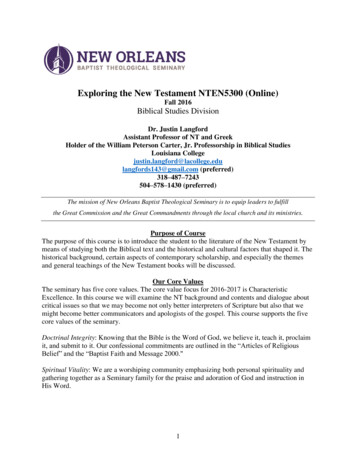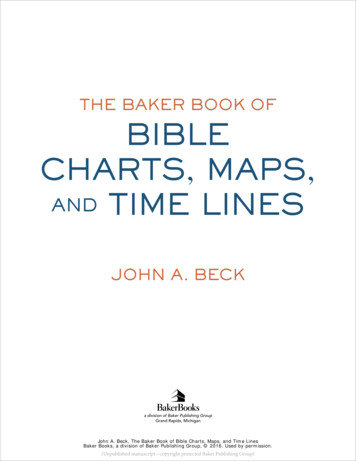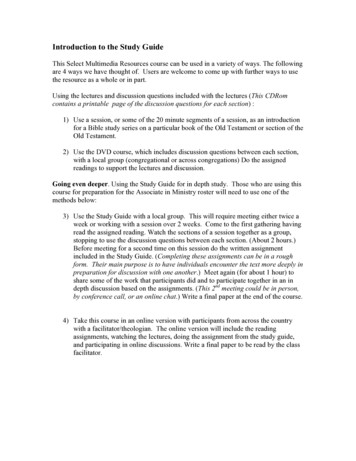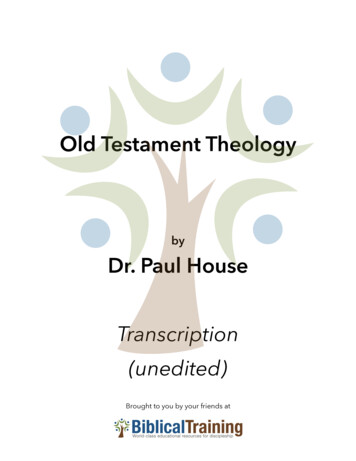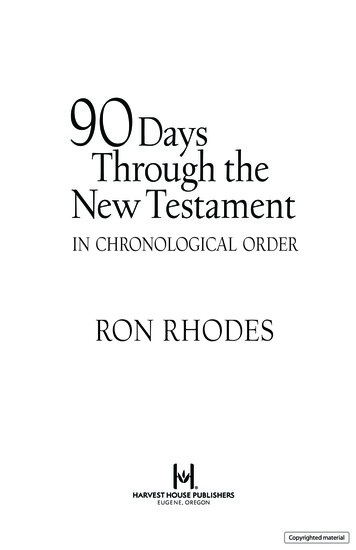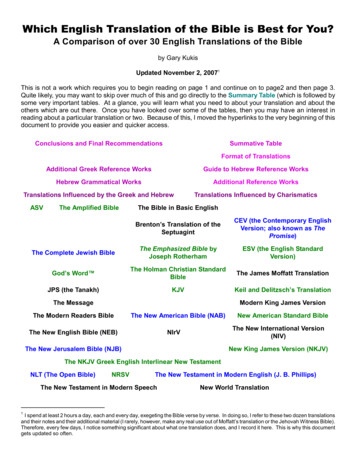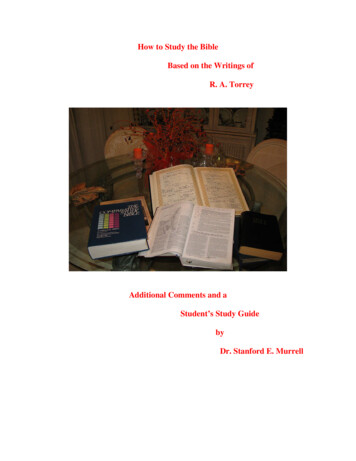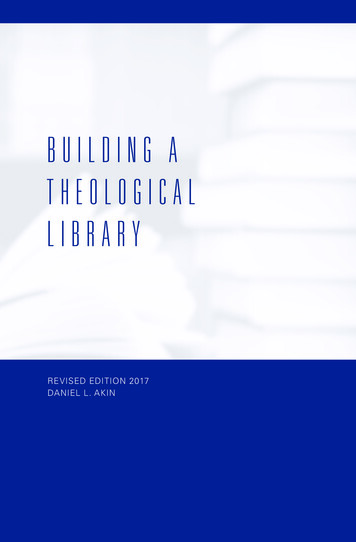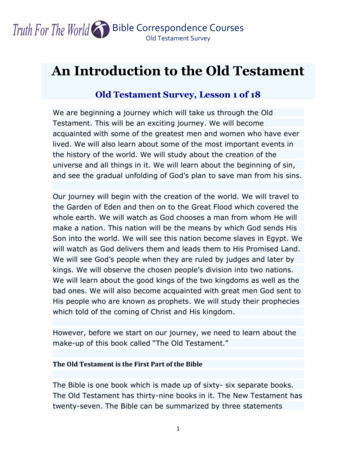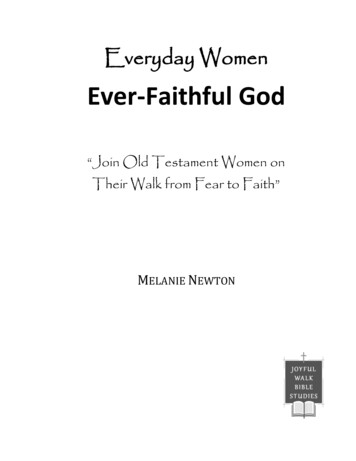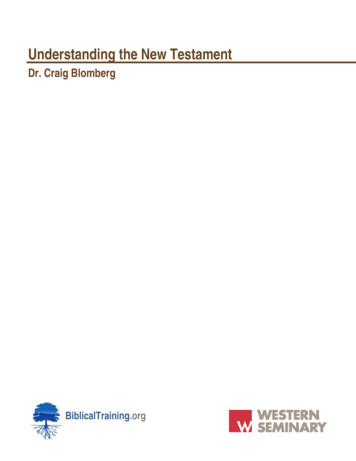
Transcription
Understanding the New TestamentDr. Craig BlombergBiblicalTraining.orgPage 1
Table of ContentsStudy 1: Why and How Should You Study the New Testament?3Study 2: Understanding the Background of the New Testament9Study 3: An Introduction to the Canon & Text of theNew Testament12Study 4: An Introduction to the Four Gospels18Study 5: A Harmony of the Gospels – Part 124Study 6: A Harmony of the Gospels – Part II29Study 7: A Harmony of the Gospels (Part III) and anIntroduction to Acts34Study 8: The Book of Acts (part II), Galatians, and1 Thessalonians39Study 9: Second Thessalonians and First Corinthians47Study 10: Second Corinthians and the Prison Epistles54Study 11: The Prison Epistles (part 2), Pastoral, andGeneral Epistles (part 1)61Study 12: The General Epistles (part 2) and Revelation70Page 2
Introducing the New Testament Part ONEStudy 1: Why and How Should You Study the New Testament?I. What is the New TestamentA. The New Testament Canon1. The 27 Books of the New Testament2. Definition of "canonization""coming to understand this collection of works as uniquely inspired and Godbreathed."B. The Genres of the New Testament1. The Gospels (Biography)a. Books: Matthew, Mark, Luke, Johnb. Definition of Gospel:"good news"c. The Content of the Four Gospelsd. The Reason for Having Four Gospelse. The Order of the Four GospelsChristians believed [Scripture] to be God's very word tohumanity and thus making it crucial for followers of Christ tounderstand it, to apply it, and to obey it. Biblical Training and Western SeminaryPage 3
2. Acts of the Apostles (History)a. Books: Actsb. Definition:"we may think of it more along the lines of the broader historywriting of the ancient Mediterranean world."c. The Content of Acts3. Letters (Epistles)a. Paul's Lettersi. Books: Romans, 1 & 2 Corinthians, Galatians, Ephesians,Philippians, Colossians, 1 & 2 Thessalonians, 1 & 2Timothy, Titus, Philemon, and maybe Hebrewsii. The Order of the Pauline Epistlesb. General Epistlesi. Definition:"they were at one time believed to have been written to morethan one single church"i. Books: maybe Hebrews, James, 1 & 2 Peter, 1, 2, & 3John, and Judeii. The Order of the General Epistles: Biblical Training and Western SeminaryPage 4
4. Apocalypsea. Definition: "revelation""a highly symbolic description of present and future events in light ofquestions about the way the world will end."b. Books: Revelationc. The Content of RevelationII. Why Study the New Testament?A. The Literary ReasonB. The Historical ReasonC. The Contemporary ReasonD. The Academic ReasonE. The Personal ReasonF. The Professional Reason Biblical Training and Western SeminaryPage 5
III. How Should We Study the New Testament?A. Questions of BackgroundWho wrote it? To whom? When? Under what circumstances? Why was it written?B. Questions of InterpretationHow should the book be outlined? What is its overall structure? What are its main points? Whatis clear? What is disputed? What are the best solutions?C. Questions of ThemeWhat are the key themes overall? Is there a unifying or central topic? Are there any problems ordifficulties with these main themes?D. Questions of ApplicationWhat are some key points that can be applied to life and ministry today?IV. What Are the Possible Viewpoints on the New Testament?A. Three Main Perspectives1. The Religious Viewpoint2. The Irreligious Viewpoint3. The Christian Viewpoint Biblical Training and Western SeminaryPage 6
B. Diverse Christian Perspectives1. The Conservative Evangelical Perspective2. The Liberal Perspective3. Denominational Perspectives4. The Eastern Orthodox Perspective5. The Roman Catholic Perspective6. The Protestant PerspectiveC. Other Perspectives (e.g., Mormon, Jehovah's Witness, etc.) Biblical Training and Western SeminaryPage 7
V. Should We Evaluate the New Testament from Our Perspective?A. We should critically analyze the text and weigh the evidence.B. We should search the Scriptures.C. We should be open to learning something new.FOR FURTHER REFLECTION1. Why might it be important to understand the different "genres" of the NewTestament? What difference might it make in how we read the various books ofthe New Testament?2. This study identified a number of different reasons for learning about the NewTestament. Which of these reasons comes closest to the reason that you arelearning about the New Testament? Can you think of any other reasons? Howmight you use some of these reasons to encourage someone else to learn moreabout the New Testament?3. The study identified four different kinds of questions that should be addressedin studying the New Testament. Why are these all important? Which of theseinterests you the most? Why?4. Why is it important to understand the different "perspectives" that people bringwith them when they read the New Testament? What is your perspective? Howmight it influence the way you read the New Testament? How might this be agood thing? How might it be a bad thing? Biblical Training and Western SeminaryPage 8
Study 2: Understanding the Background of the New TestamentI. The Historical & Political Background of the New TestamentA. The Four Eras of Political Influence1. The Persian Era (425-330 BC)2. The Greek Era (331-160 BC)a. The Spread of the Greek Languageb. The Spread of Greek Religions3. The Hasmonean (Maccabean) Era (142-63 BC)a. The Jewish Revoltb. The Growing Tension between Jew & Gentile4. The Roman Era (63 BC – 3rd century AD)a. The Roman Culturei. A Common Languageii. An Empire Wide Transportation/Communication Systemiii. The Pax Romana (Roman Peace)iv. Roman Law Biblical Training and Western SeminaryPage 9
b. Roman Persecutioni. Nero's Persecution (64-68 AD)ii. Domitian's Persecution (94-96 AD)II. The Religious Background of the New TestamentA. The Greek ReligionsB. The Imperial CultC. The Mystery ReligionsD. Greek Philosophical Systems1. The Epicureans2. The Stoics3. The Cynics/Skeptics Biblical Training and Western SeminaryPage 10
III. The Jewish Background of the New TestamentA. The Pharisees (and Scribes)B. The SadduceesC. The EssenesD. The ZealotsFOR FURTHER REFLECTION1. Why is it important for us to understand the historical and political context inwhich the New Testament books were written? Do you think it will make adifference in how you understand the New Testament? Why?2. Did you find it helpful to reflect on the religious background of the NewTestament? Read Acts 17:18. How does understanding these religiousperspectives help us understand the groups mentioned in these verses?3. What have you learned about the Pharisees and Sadducees? Read Acts 23:6-8.How does understanding the Jewish background of the New Testament helpyou understand this passage? Why is that important? Biblical Training and Western SeminaryPage 11
Study 3: An Introduction to the Canon & Text of the New TestamentI. How was the Old Testament Canon Determined?A. What is "Canon"?Canon deals with "how the various books were measured or analyzed in order to determinewhat would be considered uniquely sacred."B. The Apocryphal BooksC. The PseudepigraphaII. How was the New Testament Canon Determined?A. Why were any books added to the Old Testament Canon?1. The Open-ended Nature of the Old Testament2. The Establishment of the New Covenant3. Jesus's Promises to the Disciples Biblical Training and Western SeminaryPage 12
B. Why these particular 27 books?1. They were widely accepted by the Church as uniquely true and inspired.2. They were linked to an Apostle.3. They did not contradict previous Scripture.C. What about those writings that were left out?1. The Apostolic Fathers2. The New Testament Apocrypha3. The Gnostic WritingsD. What if we found new writings?More theologically decisive is the Christian conviction thatJesus was God's final and decisive word for humanity, for oursinful plight, and for the salvation that we, therefore, foundourselves in need of. Biblical Training and Western SeminaryPage 13
II. Is the Text of the New Testament Reliable?A. The Number of Manuscripts (i.e copies)B. The Nature of the DiscrepanciesC. Some Longer Disputable Passages1. The Ending of the Lord's Prayer (Mat 6:13)2. The Ending of Mark (Mark 16:9-20)3. The Woman Caught in Adultery (John 7:53-8:11)D. The Verse and Chapter Markers"It is important to stress that no Christian doctrine depends onlyon some disputed text and, therefore, even if we do not have theoriginal documents we have copies that have been preservedwith remarkable care in which we can place our trust." Biblical Training and Western SeminaryPage 14
III. The Four GospelsA. The Similarities and Differences among the Gospels1. "Harmonies" of the Gospels2. The "Synoptic" Gospels3. The Uniqueness of John.B. Other Early Sources of Information about the Life of Christ1. What other sources do we have?2. What can we learn about Jesus from these sources?3. What should we conclude from this information?"Certainly no one in the earliest centuries of Christian history,inside or outside of the movement, suspected that one day itwould grow to be the religion that claimed more followers thanany other religion in the world." Biblical Training and Western SeminaryPage 15
C. Methods for Explaining the Differences among the Gospels1. The Traditional Approach2. Source CriticismDefinition: determining the source(s) from which the biblical authors drewtheir material.3. Form CriticismDefinition: determining the original (oral) form in which the biblical materialwas passed on from one generation to the next.4. Redaction CriticismDefinition: analyzing the editorial process that produced the final version ofthe biblical texts.5. Socio-historical CriticismDefinition: analyzing the social-historical context in which the New Testamentbooks were written. Biblical Training and Western SeminaryPage 16
D. Explaining the Uniqueness of the Gospel of John1. The Traditional Explanation: Familiarity with the Synoptics2. The Modern Explanation: Unfamiliarity with the Synoptics3. A Hybrid Approach: Familiarity with the StoriesFOR FURTHER REFLECTION1. Why do you think the early church believed it was important to establish whichbooks of the Bible were "canonical"? Does it change how you view the NewTestament to know that these books were intentionally and thoughtfullyselected as being uniquely authoritative and inspired?2. Does it bother you to realize that there are differences and discrepancies amongthe various copies of the New Testament? How might our confidence in thesovereignty of God and the continual work of the Holy Spirit help us deal withour concerns in this area? How could you encourage someone who wasstruggling with whether these discrepancies meant they could no longer trustthe Bible?3. In what ways are the four Gospel accounts similar? In what ways are theydifferent? Why are these differences important? Why might these differencesalso cause problems?4. What do you think of the various ways that people have come up with toexplain the differences among the Gospels? How might each of these help usunderstand how the Gospels were written? Pause for a moment and putyourself in the place of the biblical authors as they sorted various sources(source criticism) and oral traditions (form criticism), editing them together(redaction criticism) to present an account of Jesus's life that would bemeaningful in their cultural context (socio-historical criticism). How can thishelp you appreciate these authors and what they accomplished? How was theHoly Spirit involved in all of this? Why is that important? Biblical Training and Western SeminaryPage 17
Study 4: An Introduction to the Four GospelsI. IntroductionA. DefinitionB. The Content of the GospelsC. The Gospels as Ancient BiographiesII. The Gospel of MarkA. The Background of Mark1. Author2. Date3. Purpose"Mark is concerned to emphasize aspects of Jesus's life andministry that can bring encouragement and comfort toChristians who are suffering." Biblical Training and Western SeminaryPage 18
B. The Major Themes of Mark1. Jesus as "Son of God" (Mark 15:39)2. Jesus as "Christ" (Mark 8:27-30)3. Jesus as "Suffering Servant" (Isa 53; Mark 10:45)4. The Disciples' Inability to Understand (Mark 8:31-33)C. Applying the Gospel of Mark1. It helps us understand the fundamental themes and events of JesusChrist's life.2. It encourages Christians in the midst of adversity.III. The Gospel of MatthewA. The Background Of Matthew1. Author2. Date3. Purpose Biblical Training and Western SeminaryPage 19
B. The Major Themes of Matthew1. Jesus as "Teacher"a. The Sermon on the Mount (Matt 5-7)b. The Commissioning of the Twelve (Matt 10)c. The Parables (Matt 13)d. The Teaching on Humility and Forgiveness (Matt 18:1-6; 15-35)e. The "Woes" and the Second Coming (Matt 24-25)2. Jesus as "Son of David" (Matt. 9:27; 15:22; 21:9, 15)3. The Progression of the Gospel Offer (Matt. 28:16-19)C. Applying the Gospel of Matthew1. It is most helpful for those with a Scriptural background.2. It stimulates the mission of the Church.3. It provides material for ethical reflection. Biblical Training and Western SeminaryPage 20
IV. The Gospel of LukeA. The Background of Luke1. Author2. Date3. PurposeB. The Major Themes of Luke1. The Humanity of Jesus (Luke 4:31-41; 5:12-26)2. Jesus as "Teacher" (Luke. 15-16)3. The Power of Prayer (Luke 18:1-8)4. The Importance of the Holy Spirit (Luke 10:21-24)5. The Importance of Stewardship (Luke 16:10; 19:19-26)”Inasmuch as many have undertaken to compile a narrative ofthe things that have been accomplished among us that youmay have certainty concerning the things you have been taught.”Luke 1:1, 4 Biblical Training and Western SeminaryPage 21
V. The Gospel of JohnA. The Background of John1. Author2. Date3. PurposeB. The Major Themes of John1. Jesus as "Son of God" and "Christ" (John 20:31)2. The Importance of Evangelism (John 3:16-21)3. Jesus as "Word of God" (John 1:1)4. Jesus as "Lamb of God" (John 1:29, 36)5. Jesus as "God Incarnate" (John 10) Biblical Training and Western SeminaryPage 22
6. The "I am" Sayings (John 6:48; 8:12, 58; 10:9, 11; 11:25; 14:6; 15:1)7. The Presence of Eternal Life (John 3:16; 6:35-71)8. The Miracles as Key Signs Pointing to Jesus's Identity (John 9:1-41)9. Jesus's Private Teaching of the Disciples (John 13-17)a. The Unity between the Father and the Sonb. The Unity between the Son and His Followers10. The Eternal Security of the Believer (John 6:39)FOR FURTHER REFLECTION1. Read Isaiah 53, Mark 8:31 and Mark 9:12. How do these passages help youunderstand who Jesus was and what he did? How could you use these passagesto encourage someone who was enduring persecution or suffering?2. One of the key themes for the Gospel of Matthew is that Jesus is a teacher.Spend some time looking through the Sermon on the Mount to see what kindsof things Jesus taught about (Matt 5-7). Pick one part of the Sermon and spendsome time reflecting on what it would have been like to hear Jesus preach thesewords to his disciples. What would it be like to hear him preaching these wordsto your church today? How should you live in light of these words?3. Read Luke 2:52. What does this verse tell us about the humanity of Christ?Why is the humanity of Christ such an important issue for Luke? Why is itimportant that we understand the humanity of Christ today? Read Hebrews2:17-18. How can Christ's humanity be a source of encouragement for us?4. Read John 1:1-18. What does it mean to say that the 'Word' became 'flesh'?What can you do this week to reflect more deeply on what an amazing truththis is? What can you do this week to help someone else understand andappreciate this truth? Biblical Training and Western SeminaryPage 23
Study 5: A Harmony of the Gospels – Part 1I. An Overview of Jesus's LifeA. Jesus's Birth (4-6 BC)B. Jesus's Adult Ministry (AD 27-30)1. The Passover Narratives in John2. Jesus's Three-Year Ministrya. The Phase of Obscurityb. The Phase of Popularityc. The Phase of RejectionII. The Birth of JesusA. The Birth of Jesus in Matthew and Luke1. The fulfillment of OT prophecy2. The Virgin Birth3. Jesus's Infancy4. Jesus's Childhood Biblical Training and Western SeminaryPage 24
III. The Phase of ObscurityA. The Beginning of Jesus's Public Ministry1. The Starting Point in Mark & John2. John the BaptistB. Jesus's Baptism1. Baptism in Judaism2. The Reasons for Jesus's BaptismC. Jesus's Temptation1. Common to all 3 Synoptics2. The Three Temptationsa. Turn Stones to Breadb. Rule All Kingdomsc. Jump from the Temple”For we do not have a high priest who is unable to sympathizewith our weaknesses, but one who in every respect has beentempted as we are, yet without sin.” Hebrews 4:15 Biblical Training and Western SeminaryPage 25
3. The Significance of the Temptationa. These temptations are common to all people (1 John 2:16)b. Jesus is just like us, yet without sin (Heb 2:17-18)c. Jesus can sympathize with our weaknesses (Heb 4:14-16)d. We can resist temptation as well (1 Cor 10:13)D. Events Unique to the Gospel of John1. The Four Main Episodesa. Turning Water into Wine (John 2:1-13)b. Clearing the Temple (the first time) (2:13-22)c. Jesus and Nicodemus (John 3:1-21)d. Jesus and the Samaritan Woman (John 4:1-45)2. A New and More Universal Salvation Biblical Training and Western SeminaryPage 26
IV. The Phase of PopularityA. IntroductionB. Jesus Announces the Kingdom & Calls for Repentance (Mark 1:14-15)1. The Kingdom as the Heart of God's Ministry2. The Nature of the Kingdom3. The Nature of RepentanceC. Jesus Calls the DisciplesD. Jesus's Healing Ministry1. Miracles and Mythology2. Miracles as Testimonies of the Kingdom Biblical Training and Western SeminaryPage 27
E. The 'Conflict' Stories1. The Healing of the Paralytic (Mark 2:1-12)2. The Calling of Sinners (Mark 2:13-17)3. The Sabbath Laws (Mark 3:1-6)4. The True Family (Mark 3:31-35)F. Jesus's Public Ministry ChallengedFOR FURTHER REFLECTION1. Why do you think it is important for believers to reflect on Jesus's birth andchildhood? Why is the Virgin Birth important? Do you think thatunderstanding Jesus's birth and childhood has any significance for life andministry today? Why or why not?2. Read Hebrews 4:14-16. According to this passage, why can we draw near toGod's throne with confidence? What difference might this make in our prayerand worship lives? How can this help us appreciate the importance of Jesus'slife on earth?3. According to Jesus's message, what lies at the heart of God's ministry? Howmight this affect the way that we understand the Gospel? How can we makethis a more prominent part of our own lives and ministries?4. What can we learn from the controversies and challenges that surroundedJesus's public ministry? How can this become a source of motivation andencouragement to us in difficult times? Biblical Training and Western SeminaryPage 28
Study 6: A Harmony of the Gospels – Part III. The End of the Phase of PopularityA. The Parables1. The Purpose of the Parables (Luke 8:9-15)2. The Nature of the Parables3. The Parable of the Prodigal Son (Luke 15:11-32)4. The Good Samaritan (Luke 10:29-37)B. The Nature Miracles1. Resurrection from the Dead (Mark 9:30-32)2. Walking on Water (Mark 6:45)3. Calming the Storm (Mark 4:35) Biblical Training and Western SeminaryPage 29
C. Jesus's Teaching on Kingdom Ethics (Mark 7:1-8:26)D. Jesus Confessed as Messiah (Mark 8:27-9:1)E. Additional Material in Matthew1. The Sermon on the Mount (Matthew 5-7)2. The Sermon on Mission (Matthew 10)3. The Sermon on the Parables (Matthew 13)4. The Sermon on Humility (Matthew 18:1-6)5. The Sermon on Last Things (Matthew 24-25) Biblical Training and Western SeminaryPage 30
E. Additional Material in LukeF. Additional Material in John1. Jesus Healing on the Sabbath (John 5)2. The Feeding of the 5,000 (John 6)3. Jerusalem Ministry (John 7-9)4. Jesus as the Good Shepherd (John 10)II. The Phase of RejectionA. The Key Turning Point – Raising Lazarus (John 11)B. A Changing Message (Mark 10) Biblical Training and Western SeminaryPage 31
B. Passion Week1. Entering Jerusalem (Matt. 21:1-9; Mark 11:1-11; Luke 19:28-44; John12:12-19)2. Clearing the Temple (Matt. 21:12-17; Mark 11:15-19; Luke 19:45-48)3. Cursing the Fig Tree (Matt. 21:18-22; Mark 11:12-14)4. Confronting the Jewish Leaders (Matt. 21:23-22:14; Mark 11:27-12:12;Luke 20:1-19)5. Sermon on the Mt. of Olives (Matt. 25:1-51; Mark 13:1-37; Luke 21:5-36)6. The Last Supper (Matt. 26:26-29; Mark 14:22-25; Luke 22:17-20)a. The Bread and the Wineb. Anticipating the Coming Banquet Biblical Training and Western SeminaryPage 32
c. Jesus's Teaching7. The Garden of Gethsemane (Matt. 26:30; 36-46; Mark 14:26, 32-42; Luke22:39-46; John 18:1)FOR FURTHER REFLECTION1. Read Luke 15:11-32. What does this parable reveal about the nature of God'slove and grace? In what ways are you like the younger son? In what ways areyou like the older son? What can you do this week to reflect God's love andgrace in your home and/or workplace?2. Read Mark 4:35-41. What does this story reveal about Jesus? What does it sayabout the disciples? Are there areas in your life where you are fearful and needto learn to trust Jesus more? What can you do this week to remind yourself thatJesus is Lord over that issue as well?3. This study emphasized the 'urgency' of the disciples' mission (cf. Matt 10). Howurgent is this mission today? How urgent is the mission in your own life? Inyour church?4. Read John 17:11. Why do you think Jesus emphasized Christian unity so muchin his prayer? How do you think this relates to the existence of so manyChristian denominations? Can you think of any ways in which your churchcould work toward greater unity and cooperation with other churches? Biblical Training and Western SeminaryPage 33
Study 7: A Harmony of the Gospels (Part III) & an Introduction to ActsI. The Passion of ChristA. The Trial of Jesus1. Jesus before the High Priest (Matt. 26:57-68; Mk.14:53-65; Lk. 22:54-65; Jn. 18:24)2. Jesus as the Messiah (Matt. 27:11; Mk. 14:61-64,Lk. 22:67-71; Jn. 18:33-38)3. Peter's Denial (Matt. 26:58, 69-75; Mk. 14:54, 6672; Lk. 22:54-62; Jn. 18:15-18, 25-27)4. The Charge against Jesus (Matt. 27:1; Mk. 15:1;Lk. 22:66-71)5. Jesus before Pilate and Herod Antipas (Matt.27:2, 11-14; Mk. 15:1-5; Lk. 23:1-12; Jn. 18:28-38)B. The Crucifixion1. The Nature of Crucifixion (Matt. 27:27-50; Mk.15:16-37; Lk. 23:26-46; Jn. 19:16-27)2. The Death of Jesus (Matt. 27:51-56; Mk. 15:3841; Lk. 23:45-49; Jn. 19:28-30)“But may it never be that I would boast, except in the cross ofour Lord Jesus Christ, through which the world has beencrucified to me, and I to the world.” Galatians 6:14 Biblical Training and Western SeminaryPage 34
3. The Seven Last Sayings of Jesus on the Crossa. “Father, forgive them for they know not what they do.” (Lk. 23:34)\b. “Truly I say to you, today, you will surely be with me in paradise.”(Lk. 23:43)c. “Woman behold thy son. Son, behold thy mother.” (Jn. 19:26-27)d. “My God, my God, why have you forsaken me?” (Matt. 27:46; Mk. 15:34)e. “I thirst.” (Jn. 19:28)f. “It is finished.” (Jn. 19:30)g. “Father, into thy hands I commit my spirit.” (Lk. 23:46)C. The Resurrection1. The Significance of the Resurrection2. Alternative Explanations of the Resurrectiona. The Swoon Theoryb. The Stolen Body Theoryc. The Wrong Tomb Theoryd. The Hallucination Theorye. The Late Legend Theory Biblical Training and Western SeminaryPage 35
3. The Resurrection Accepteda. The Women as Eyewitnessesb. Sunday Worshipc. Jesus Worshippedd. The Solidarity of Early Christianitye. Paul's Testimony (1 Cor. 15)II. An Introduction to ActsA. Background to the Book of Acts1. The Author of Acts2. Date: AD 623. The Audience of Acts“This Jesus, delivered up according to the definite plan andforeknowledge of God, you crucified and killed by the handsof lawless men. God raised him up, loosing the pangs ofdeath, because it was not possible for him to be held by it."Acts 2:23-24 Biblical Training and Western SeminaryPage 36
4. The Purpose of Actsa. To Show the Progress of the Gospel (1:8)b. To Show the Shift from Jerusalem to Rome (8:26-40)c. To Show the Shift from Jewish to Gentile (10:1-43)d. To Show the Ministry of the Early Churche. To Show the Ministry of Peter & Paulf. To Defend Christianity from CriticismB. Possible Outlines of Acts1. Jerusalem, Judea, Samaria, and the End of the World2. "The Word of God grew and spread "C. An Outline of Acts1. Acts 1:1-6:7a. Date: AD 30-32b. Jesus's Appearance and Ascensionc. The Day of Pentecostd. Civil Disobedience Biblical Training and Western SeminaryPage 37
e. Caring for the Poorf. Annanias and Sapphirag. The First Deacons2. Acts 6:8-9:31a. Date: AD 33-47b. The Stoning of Stephenc. Philip's Ministry in Samariad. The Main Theme: The Word of God Spreading to the Unlikelye. The Work of the Spirit Debatedf. The Conversion of Saul\FOR FURTHER REFLECTION1. Look at "The Seven Last Sayings of Jesus on the Cross." Pick one and spend alittle time reflecting on it. What does it tell you about Jesus's experience on thecross? How can this saying help you appreciate what Jesus did?2. Read 1 Corinthians 15:12-19. According to Paul, why is it so important that webelieve in the resurrection? How often do you reflect on the importance of theresurrection? What can you do this week to remind yourself of how importantit is that Jesus was raised from the dead?3. Read Acts 2:38. What is the "gift of the Holy Spirit"? Why do you think that itis important for Christians to understand that they have received the gift of theHoly Spirit? How does it help you to understand that you too have received thegift of the Holy Spirit?4. Look over the various purposes of the Book of Acts. Which of these do youneed to understand better? What can you do this week to develop a deeperunderstanding of this theme? Biblical Training and Western SeminaryPage 38
Study 8: The Book of Acts (part II), Galatians, and 1 ThessaloniansI. The Book of Acts (part II)A. Acts 9:32-12:241. Peter's Vision2. Cornelius' Conversion3. The Gospel Moving OutB. Acts 12:25-13:11. The Focus Shifts to Paul2. The Pattern of Paul's MinistryC. Paul's Missionary Journeys1. The First Missionary Journey (13:4-14:28)a. Date: AD 47-49b. The Ministry in Cyprusc. The Journey to Pisidiad. Other Journeys Biblical Training and Western SeminaryPage 39
2. The Jerusalem Council (15:1-35)a. The Reasons for the Councilb. The Theological Conclusion: Salvation through Faith Alonec. The Practical Conclusion: Some Restrictions for the Purpose ofUnity3. The Second Missionary Journey (15:36-18:22)a. Revisiting Earlier Churchesb. Lydia and the First Convertsc. Paul's Arrest in Philippid. Paul's Mars Hill Speech in Athense. The City of Corinthf. The Return to Antioch Biblical Training and Western SeminaryPage 40
4. The Third Missionary Journey (18:23-21:16)a. Paul's Ministry in Ephesusb. The Riot in Ephesusc. The Offering for Jerusalem5. The Trials of Paul in Jerusalem and Caesarea (21:17-26:32)a. Paul's Arrest in Jerusalemb. Paul Imprisonedc. The Attempt on Paul's Life and His rescued. Paul's Appeal to Rome6. Paul's Journey to Rome (27:1-28:31)a. God's Promiseb. The Island of Maltac. Paul's Arrival in Rome“God’s sovereign plans and responsible human actions arenever pitted against one another in scripture, but work handin hand.” Biblical Training and Western SeminaryPage 41
D. Four Key Theological Emphases1. God oversees the progress of the Church.2. The message of Christianity centers on the resurrection of Jesus.3. The offer of salvation is for all people.4. The Church will flourish despite opposition.E. Two Key Applications1. Understanding the Nature of Salvationa. Through repentance and faith in Jesus Christb. Outwardly symbolized by baptismc. Inwardly ratified by the Holy Spirit2. Looking for Lessons for the Church Todaya. Find the constant in the patterns.b. Recognize that methods are variable.“Do not call anything impure that God has made clean.”Acts 10:15 Biblical Training and Western SeminaryPage 42
II. GalatiansA. The Background of Galatians1. Recipients: Psidian Antioch, Iconium, Lystra, Derbe2. Date: AD 49a. Between the 1st missionary journey and the Jerusalem Councilb. Before the declaration on unclean foods3. Paul’s use of the word “bewitched” (3:1)B. Keys to Understanding Galatians1. Understanding the Law2. Debating with the JudaizersC. Outlining Galatians1. Paul Defends His Authority (1:1-2:14)a. His Calling from Godb. His Mission Affirmedc. His Rebuke of Peter Biblical Training and Western SeminaryPage 43
2. Paul Defends Justification by Faith Alone (2:15-4:31)a. Abraham Justified by Faithb. The Nature of the Lawc. Salvation for both Jew and Gentile3. Paul Describes the Nature of Christian Freedom (5:1-6:17)a. Freedom from the Law, not from moralityb. Faith expressed through lovec. A life directed by the Spiritd. The new life not produced by Lawe. The Gospel as a fulfillment of the Law Biblical Training and Western SeminaryPage 44
D. The Theology of GalatiansIII. First ThessaloniansA. The Background of First ThessaloniansB. An Outline of First Thessalonians1. Greeting and Exhortation (1:1-3:13)a. Praise to Godb. The Thessalonians as an Example to the Churchesc. The Gospel as God's Divine Wordd. An Encouragement to Continued Growth“Galatians is the charter of Christian liberty—a foundationaldocument defining how Christians become free. Free from the sinthat enslaves them. Free from the penalty of that sin, and thus freeto establish a relationship with God through the work of Christ onthe cross, empowered by the Holy Spirit who comes to dwell inbelievers, and produces the good works that do not save, butdemonstrate the presence of salvation in an individual.” Biblical Training and Western SeminaryPage 45
2. A Call to Godly Living (4:1-5:28)a. Living a Holy Life i
Study 5: A Harmony of the Gospels – Part 1 24 Study 6: A Harmony of the Gospels – Part II 29 Study 7: A Harmony of the Gospels (Part III) and an Introduction to Acts 34 Study 8: The Book of Acts (part II), Galatians, and 1 Thessalonians 39 S
